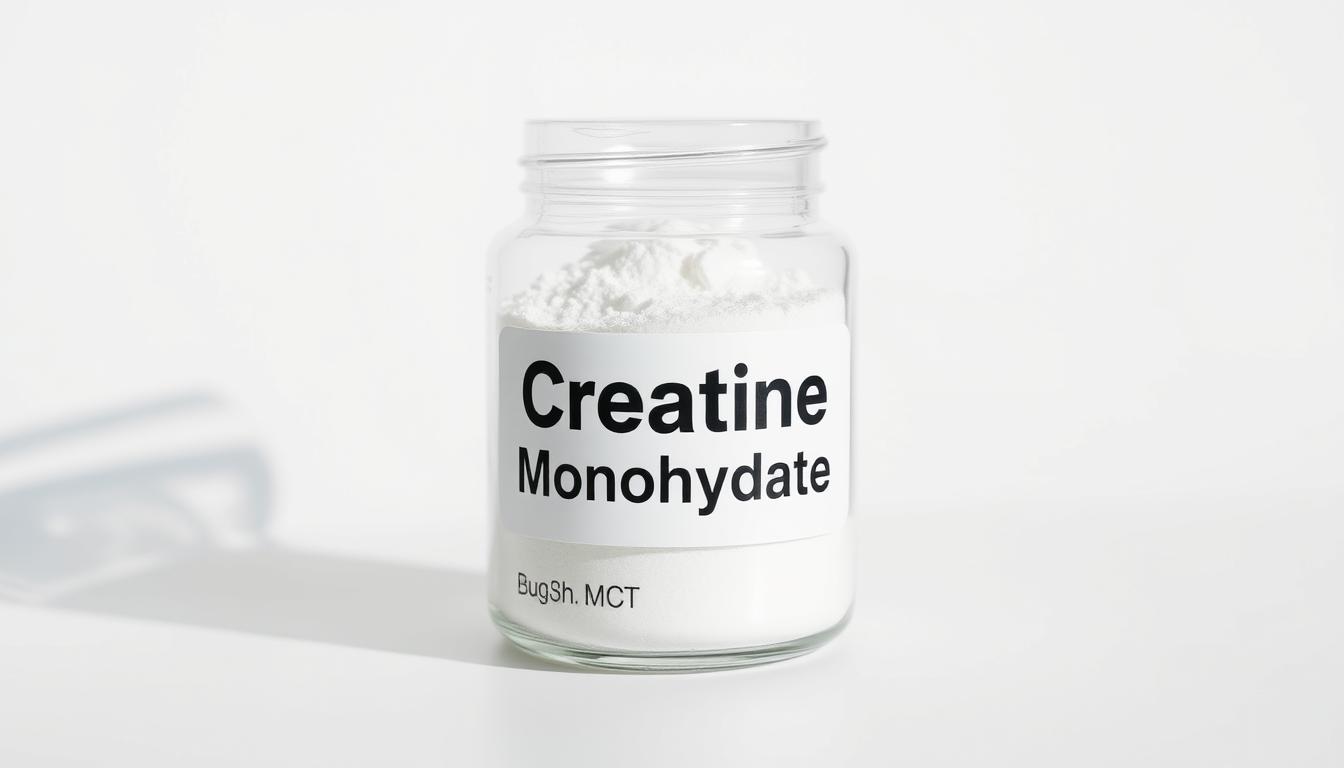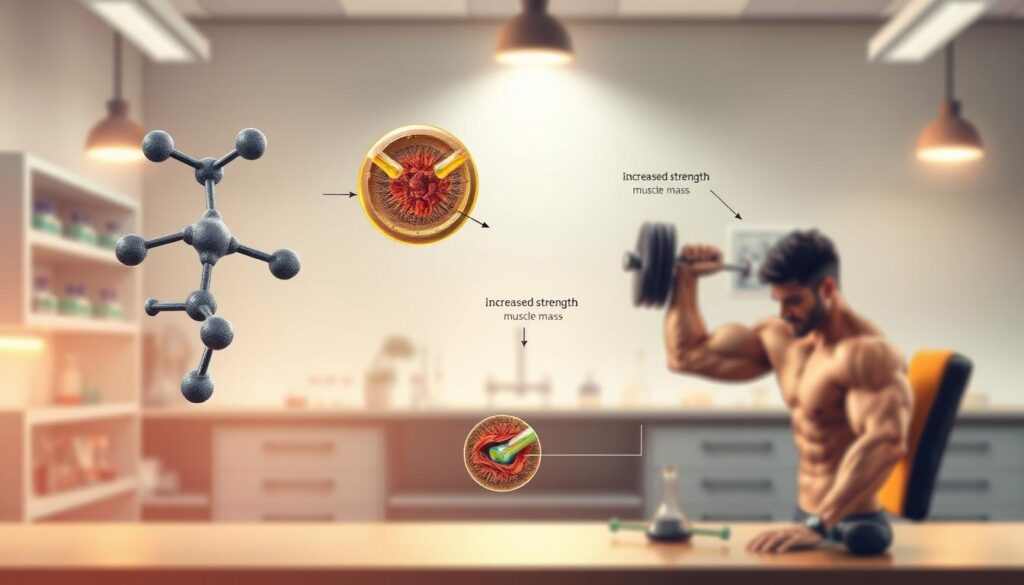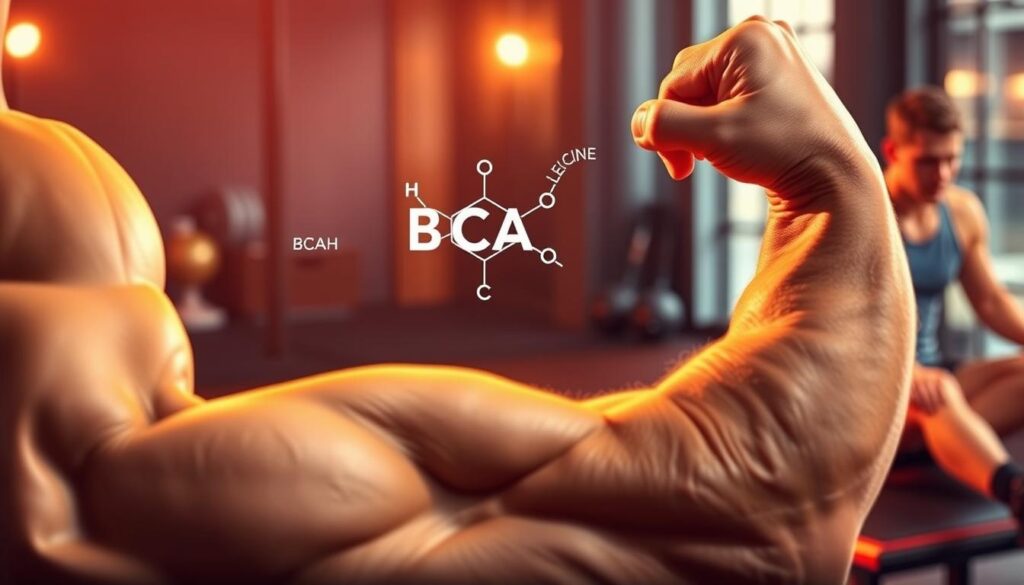Blog
Creatine Supplementation: The Science-Backed Guide to Muscle Gain and Performance

Athletes and fitness enthusiasts continually seek effective ways to enhance muscle gain and boost athletic performance. One widely researched and utilized supplement is Creatine, a substance that has been proven to significantly impact muscle power output and overall physical performance.
Studies have shown that Creatine supplementation can lead to substantial improvements in muscle strength and endurance. According to a study published on the National Center for Biotechnology Information website, Creatine supplementation increases muscle power output and enhances lean soft tissue, making it a valuable addition to any fitness regimen.
Key Takeaways
- Creatine supplementation enhances muscle power output and strength.
- It improves lean soft tissue and skeletal muscle mass.
- Effective dosage strategies include a loading phase followed by a maintenance phase.
- Creatine can lead to significant improvements in athletic performance.
- It is a well-researched supplement with proven benefits.
What Is Creatine and How Does It Work?
To understand the benefits of creatine, it’s essential to grasp the science behind it and how it works within the body. Creatine is a naturally occurring substance found primarily in red meat and fish, and it’s also produced by the human body in limited quantities.
The Science Behind Creatine Phosphate
Creatine phosphate, or phosphocreatine, is a high-energy compound that rapidly replenishes ATP (adenosine triphosphate), the energy currency of the cells. When you engage in high-intensity activities, your ATP stores are depleted quickly.
ATP-PC Energy System
The ATP-PC system is a critical energy source for short-duration, high-intensity efforts. It works by rapidly regenerating ATP from ADP (adenosine diphosphate) using the phosphate group from creatine phosphate.
Cellular Energy Production
In the context of cellular energy production, creatine supplementation increases the amount of creatine phosphate available for ATP regeneration. This process is vital for high-intensity exercise, as it allows for more reps, sets, and overall higher intensity workouts.
Natural Sources of Creatine
While the body produces some creatine, dietary sources are also important. Red meat and fish are rich in creatine. However, to achieve the performance-enhancing effects of creatine, supplementation is often necessary.
| Food Source | Creatine Content (grams per kg) |
|---|---|
| Beef | 4.5 |
| Fish | 4-5 |
| Pork | 3-4 |
How Creatine Enhances Athletic Performance
Creatine supplementation has been shown to significantly enhance athletic performance by increasing muscle strength, power, and endurance during high-intensity activities. 
By understanding how creatine works and incorporating it into your training regimen, you can potentially see improvements in your overall performance and muscle growth.
The Proven Benefits of Creatine
With a strong foundation in scientific research, creatine has emerged as a leading supplement for those seeking to improve muscle strength and endurance. The benefits of creatine supplementation are multifaceted, impacting various aspects of athletic performance and muscle physiology.
Increased Muscle Strength and Power
Creatine is well-documented to enhance muscle strength and power output. This is particularly beneficial for athletes involved in high-intensity sports.
Research on Strength Gains
Numerous studies have demonstrated that creatine supplementation leads to significant gains in muscle strength. For instance, a meta-analysis published in the Journal of Strength and Conditioning Research found that creatine supplementation resulted in an average strength gain of 8% compared to placebo.
Power Output Improvements
In addition to strength gains, creatine has been shown to improve power output during high-intensity activities. This is crucial for sports that require quick bursts of energy, such as sprinting or jumping.
Enhanced Muscle Growth and Recovery
Creatine not only enhances strength and power but also contributes to muscle growth and recovery. By allowing for more intense workouts, creatine indirectly supports muscle hypertrophy.
“Creatine supplementation has been shown to increase muscle creatine kinase activity, which is associated with improved muscle function and recovery.”
Improved High-Intensity Exercise Performance
Creatine supplementation is particularly effective for high-intensity exercise. It enables athletes to perform at higher intensities for longer durations, thereby improving overall performance.
| Benefit | Description | Impact |
|---|---|---|
| Increased Strength | Significant gains in muscle strength | Enhanced athletic performance |
| Improved Power Output | Better performance in high-intensity activities | Improved competitiveness in sports |
| Enhanced Recovery | Faster recovery between workouts | Increased training frequency and volume |
Potential Cognitive Benefits
Emerging research suggests that creatine may also have cognitive benefits, potentially improving memory and reducing mental fatigue. While more research is needed, the existing evidence is promising.
In conclusion, creatine supplementation offers a range of benefits that can enhance athletic performance, from increased muscle strength and power to improved recovery and potentially even cognitive function.
Types of Creatine Supplements
Creatine is not just one-size-fits-all; it comes in various forms to suit different athletes and goals. Understanding these differences is key to choosing the most effective supplement for your needs.
Creatine Monohydrate: The Gold Standard
Creatine monohydrate is the most researched and widely used form of creatine. It’s known for its effectiveness in increasing muscle strength and endurance. Studies have consistently shown its ability to enhance athletic performance.
Creatine HCL and Other Forms
Beyond monohydrate, other forms of creatine have emerged, including Creatine HCL, Creatine Ethyl Ester, Buffered Creatine, and Liquid Creatine. Each has its purported benefits.
Creatine Ethyl Ester
Creatine ethyl ester is designed to improve absorption, but research on its effectiveness compared to monohydrate is mixed.
Buffered Creatine
Buffered creatine is claimed to reduce stomach discomfort, but its benefits over monohydrate are not conclusively proven.
Liquid Creatine
Liquid creatine is another form, though its efficacy and stability are subjects of debate.
Which Type Is Right for You?
When choosing a creatine supplement, consider your specific needs and goals. The table below compares the different types.
| Type | Absorption | Effectiveness | Cost |
|---|---|---|---|
| Creatine Monohydrate | Good | High | Low |
| Creatine HCL | Excellent | High | Medium |
| Creatine Ethyl Ester | Variable | Medium | High |
| Buffered Creatine | Good | High | Medium |
| Liquid Creatine | Unknown | Variable | High |
Ultimately, creatine monohydrate remains the gold standard due to its proven track record and cost-effectiveness.
How to Take Creatine Effectively
To maximize the benefits of creatine supplementation, understanding how to take it effectively is crucial. The efficacy of creatine is well-documented, but its benefits can only be fully realized when taken correctly.
Determining the Right Dosage
Finding the optimal dosage of creatine is essential for achieving desired results. The dosage can depend on several factors, including body weight and activity level.
Weight-Based Calculations
A common method for determining creatine dosage is based on body weight. Typically, a dose of 0.3 grams per kilogram of body weight is recommended during the loading phase.
Activity Level Considerations
Your activity level also plays a significant role in determining the right dosage. Athletes or individuals engaging in high-intensity activities may require adjusted dosages to maximize performance benefits.
Timing: When to Take Creatine
The timing of creatine intake is another critical factor. Understanding when to take creatine can help in maximizing its benefits.
Pre-Workout vs. Post-Workout
Research suggests that taking creatine both pre-workout and post-workout can be beneficial. Pre-workout, it can enhance performance, while post-workout, it can aid in recovery.
Daily Consistency Importance
Consistency is key when it comes to creatine supplementation. Taking creatine at the same time every day helps maintain muscle saturation, ensuring continuous benefits.
Mixing and Consumption Methods
Creatine can be mixed with various beverages, but it’s essential to avoid hot water as it can degrade the creatine. Mixing it with a warm or cold drink is recommended.
Cycling: Necessary or Not?
The necessity of cycling creatine is a topic of debate. Some argue it’s necessary to avoid desensitization, while others claim it’s unnecessary due to creatine’s natural occurrence in the body.
| Cycling Strategy | Description | Benefits |
|---|---|---|
| Cycling On/Off | Alternate between periods of creatine intake and cessation | May help maintain sensitivity |
| Continuous Use | Take creatine consistently without interruption | Simplifies supplementation routine |
| Loading Phase | Initial high-dose phase followed by standard maintenance dose | Rapidly increases muscle saturation |
Ultimately, whether to cycle creatine or not depends on individual preferences and goals. Consulting with a healthcare professional can provide personalized guidance.
Creatine Loading Phase: Is It Necessary?
When starting creatine supplementation, many wonder if a loading phase is necessary. The creatine loading phase is a period where individuals consume a higher dose of creatine to quickly saturate their muscles. This approach has been debated, with some arguing it’s essential for rapid results, while others claim it’s unnecessary.
Traditional Loading Protocol
The traditional loading protocol involves taking a high dose of creatine for a short period, typically 5-7 days. There are two common methods:
20g Daily for 5-7 Days Approach
This involves consuming 20 grams of creatine per day, divided into four servings, for 5 to 7 days. This method aims to quickly increase muscle creatine levels.
Divided Dosing Strategy
Some prefer dividing the daily dose into smaller servings taken throughout the day to maintain a consistent level of creatine in the system.
Alternative Approaches
Not everyone opts for the traditional loading phase. Some individuals prefer a gradual supplementation approach, taking a standard dose of creatine (around 3-5 grams daily) without an initial loading phase.
The Science on Loading vs. Gradual Supplementation
Research indicates that both loading and gradual supplementation can effectively increase muscle creatine levels. However, the loading phase can achieve saturation more quickly.
Measuring Saturation and Results
Muscle saturation can be measured through various tests, and results can vary among individuals. The effectiveness of creatine supplementation, with or without a loading phase, depends on several factors, including individual muscle mass and overall diet.
In conclusion, whether or not to use a creatine loading phase depends on individual goals and preferences. For those seeking rapid saturation, a loading phase may be beneficial. For others, a gradual supplementation approach may be more suitable.
Potential Side Effects of Creatine
While creatine is generally considered safe, it’s essential to understand its potential side effects. Creatine supplementation has been extensively researched, and the majority of studies have found it to be well-tolerated. However, like any supplement, it’s not without potential drawbacks.
Common Misconceptions
One of the most significant barriers to creatine adoption is misinformation. Many people believe that creatine causes a range of negative side effects, from kidney damage to muscle cramps. However, numerous studies have debunked these myths, showing that creatine is safe for most people.
Research-Backed Side Effects
While generally safe, creatine can cause some side effects in certain individuals. These may include:
Water Retention and Weight Gain
Creatine can cause water retention, leading to weight gain. This is usually temporary and not a cause for concern.
Gastrointestinal Issues
Some users may experience gastrointestinal discomfort, such as bloating or stomach cramps, especially when taking high doses.
| Side Effect | Frequency | Mitigation |
|---|---|---|
| Water Retention | Common | Stay hydrated, monitor weight |
| Gastrointestinal Issues | Less Common | Take with food, reduce dosage |
Long-Term Safety Considerations
Long-term studies on creatine supplementation have shown no significant adverse effects in healthy individuals. However, it’s crucial to follow proper dosing guidelines and consult with a healthcare professional if you have pre-existing medical conditions.
Minimizing Unwanted Effects
To minimize potential side effects, it’s recommended to stay well-hydrated and follow the recommended dosage. If you experience any adverse effects, consider reducing your dosage or consulting with a healthcare professional.
Who Should (and Shouldn’t) Take Creatine
Understanding who can benefit from creatine and who should avoid it is crucial for safe and effective supplementation. Creatine is generally considered safe for most adults, but certain individuals should exercise caution or avoid it altogether.
Ideal Candidates for Creatine Supplementation
Creatine is particularly beneficial for athletes engaged in high-intensity, short-duration activities. Individuals looking to improve muscle strength, power, and endurance can also benefit from creatine supplementation. As “Creatine is one of the most well-studied supplements on the market, with a strong evidence base for its effectiveness” (1).
Contraindications and Precautions
Individuals with pre-existing medical conditions, such as kidney or liver disease, should consult their healthcare provider before taking creatine.
Pre-existing Medical Conditions
Those with kidney disease should be cautious, as creatine may affect kidney function.
Medication Interactions
Creatine may interact with certain medications, such as diuretics. Consult a healthcare professional if you’re taking any medications.
Special Considerations for Different Demographics
Creatine can be beneficial for various demographics, but special considerations apply.
Creatine for Women
Women can benefit from creatine supplementation, particularly during high-intensity training.
Creatine for Older Adults
Older adults may benefit from creatine, as it can help improve muscle strength and function.
Creatine for Teens
Teens can safely use creatine under adult supervision, but it’s essential to follow recommended dosages.
In conclusion, while creatine is generally safe, it’s crucial to consider individual factors before supplementation. Always consult a healthcare professional if you have concerns.
Combining Creatine with Other Supplements
To achieve optimal results in muscle gain and performance, understanding how to effectively combine creatine with other supplements is crucial. This strategic approach can enhance the benefits of creatine, leading to improved athletic performance and faster recovery.
Synergistic Supplement Combinations
When combining creatine with other supplements, it’s essential to choose combinations that work synergistically. One of the most effective combinations is pairing creatine with protein.
Creatine and Protein
Creatine and protein are a powerful duo. Protein provides the necessary building blocks for muscle repair and growth, while creatine enhances strength and endurance.
Timing and Ratios
The timing and ratio of creatine to protein intake can significantly impact their effectiveness. Consuming them together post-workout can be particularly beneficial.
Absorption Benefits
Some research suggests that consuming creatine with protein can enhance its absorption, potentially due to the insulin response triggered by protein intake.
Creatine and Pre-Workout Supplements
Combining creatine with pre-workout supplements can also be beneficial. Many pre-workout formulas already include creatine, making it convenient to get the benefits of both in one dose.
Creating an Effective Supplement Stack
To create an effective supplement stack, consider your specific fitness goals and choose supplements that complement creatine. A well-designed stack can include protein, pre-workout, and other performance-enhancing nutrients.
Here are some key considerations when creating your supplement stack:
- Identify your primary fitness goals.
- Choose supplements that complement creatine.
- Pay attention to the timing and ratios of supplement intake.
- Monitor your progress and adjust your stack as needed.
Debunking Common Creatine Myths
The world of sports nutrition is rife with misconceptions, particularly regarding creatine. Despite its widespread use and research-backed benefits, numerous myths surround this popular supplement. Let’s address some of the most common misconceptions to provide clarity for those considering or already using creatine.
Myth: Creatine Is a Steroid
Creatine is often mistakenly believed to be an anabolic steroid. However, creatine is a naturally occurring substance found in muscle cells, and supplementation simply increases the amount of creatine phosphate in muscles, enhancing performance without the harmful side effects associated with steroids.
Myth: Creatine Causes Kidney Damage
Numerous studies have investigated the potential link between creatine supplementation and kidney damage. The consensus is that creatine does not cause kidney damage in healthy individuals. However, those with pre-existing kidney issues should consult a healthcare professional before using creatine.
Myth: Creatine Is Only for Bodybuilders
While bodybuilders were among the first to popularize creatine, its benefits extend to various athletes involved in high-intensity sports, such as football, soccer, and sprinting. Anyone looking to improve their power output and endurance can potentially benefit from creatine supplementation.
Myth: You Must Take Creatine with Sugar
Originally, it was believed that consuming creatine with simple carbohydrates (like sugar) enhanced its absorption by stimulating insulin release. However, more recent research suggests that this may not be necessary, and creatine can be effectively taken without sugar.
Myth: Natural Athletes Don’t Need Creatine
Even athletes who maintain a natural diet and training regimen can benefit from creatine supplementation. Creatine is not a shortcut; it’s a supplement that can enhance natural performance when combined with appropriate training and nutrition.
Conclusion: Maximizing Your Results with Creatine
Incorporating Creatine into your supplement routine can be a game-changer for enhancing muscle gain and athletic performance. By understanding how Creatine works and how to use it effectively, you can unlock your full potential and achieve your fitness goals more efficiently.
To maximize your results with Creatine, it’s essential to combine it with a well-balanced diet and a consistent training regimen. The right dosage and timing can significantly impact the effectiveness of Creatine supplementation. Be sure to follow the guidelines outlined in this article to get the most out of your Creatine supplement.
By making informed decisions about your supplement routine and staying committed to your fitness goals, you can experience the benefits of Creatine supplementation firsthand. Whether you’re an athlete or a fitness enthusiast, Creatine can help you perform at your best and reach new heights in your fitness journey.





